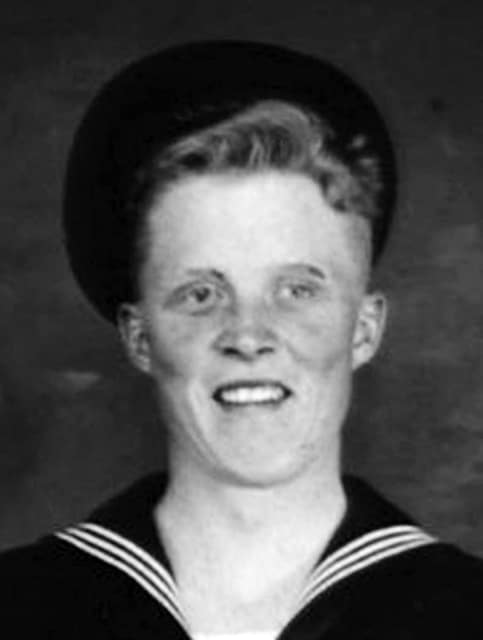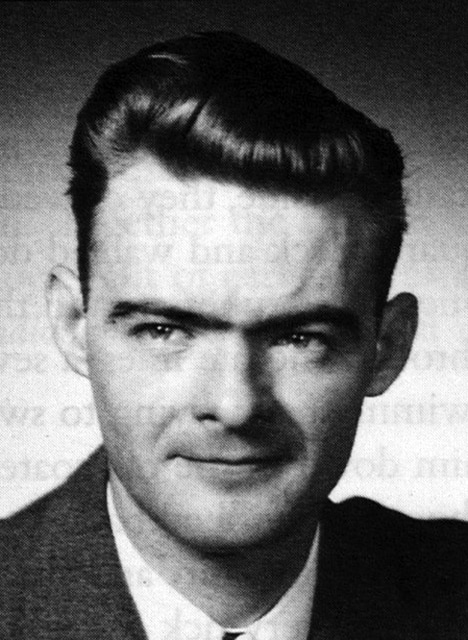

WAUSEON — In the 1940s, it was a sleepy locale of about 3,000 residents. But research recently unearthed a unique, if tragic distinction the city of Wauseon carries from the Second World War.
Two native sons, both seaman for the U.S. Navy, were victims of enemy submarine blasts that destroyed the warships on which they served. What distinguishes their stories are the time frames: one was on the very first, the other on the very last American warship sunk during the war.
“It is a claim to fame for this little community,” said Michael “The Cowboy” Stevenson.
The Florida historian spent years researching the USS Reuben James and the USS Indianapolis and their crews, and finds it astonishing that both significant incidents from World War II involved residents of Wauseon, a community located 60 miles north of Lima in Fulton County near the Michigan border.
On Oct. 31, 1941, less than two months before the Japanese attack on Pearl Harbor, 22-year old Corwin Porter was among 159 crew members on the USS Reuben James. It was part of a contingent of U.S. warships President Franklin Roosevelt ordered to escort convoys to Britain from the North Atlantic.
That day, Cmdr. Erich Topp of the U-552 submarine, and one of Germany’s top aces, ordered his crew to fire torpedoes at a freighter in the convoy. It hit the Reuben James instead, sending many of its men into the water. As the ship sank, a rack of depth charges in the aft section exploded, killing most of the surviving crew, including Porter. Only 44 seamen survived.
Topp “fired at a freighter but the Reuben James got in the way and took the hit,” Stevenson said. “We thought for sure that that was going to put America right into the war but it didn’t. The Germans said it was an accident, we were there in the way, and it kind of got smoothed over.”
The Reuben James was not as fortunate as the USS Kearny, an escort warship that had taken a torpedo hit a few weeks earlier but didn’t sink.
The loss of American lives that included the Wauseon resident reverberated so soundly that iconic folk singer Woody Guthrie penned a popular song for the time, “The Sinking of the Reuben James.”
Nearly four years later, as American troops fought the bloody battle of the Pacific theater, the USS Indianapolis completed its mission to deliver components of the atomic bomb and entered the Philippine Sea. Late on July 30, 1945, Lt. Cmdr. Mochitsura Hashimoto of the submerged Japanese submarine I-58 ordered the ship’s destruction.
Like his Indianapolis crew mates, Wauseon resident Robert Funkhouser was startled awake when the torpedoes struck. Of 1,900 crewmen, he and 900 others landed in the sea, where they discovered circling sharks.
For four nights and five days the seamen waited for rescue. They drifted in groups as far as 25 miles apart from one another, with many fighting a continuous onslaught of sharks. Many others died from drinking salt water in order to survive.
“Some of them never saw a shark, others saw more than they wished to remember,” Stevenson said.
Funkhouser, 24, was among the first 93 men to be pulled from the sea, by the USS Cecil J. Doyle. The captain, Graham Claytor Jr., had been alerted by the crew of a plane that spotted the men and landed on the water to assist.
Because the Indianapolis was a flagship it should have been escorted by a destroyer to protect against submarines.
“She was told, ‘There’s no subs there. The war’s over. You’re going in the opposite direction.’ But they were wrong,” Stevenson said.
The Indianapolis did send a distress call before it sank. The call was received at naval headquarters in the Philippines, and a lieutenant immediately sent two rescue ships. But that didn’t sit well with his commander, who was asleep when the call came in. Upset that the lieutenant acted without orders, the commander ordered the rescue ships to return.
Of the 900 men who braved hypothermia, thirst, and the ravenous sharks while floating in the sea, only 317 survived.
“Blunder after blunder, mistake after mistake was made,” Stevenson said. “You see this over and over again in the Indianapolis story. And in the end they blamed the captain.”
Capt. Charles McVay III was court-martialed and demoted in rank, and for years received accusing letters from families of his crew. He was finally exonerated of wrongdoing, but too late. Plagued by guilt, McVay committed suicide in 1968.
“It’s such a shame because he was an honorable man, and he didn’t do anything wrong, and he did the right stuff, and it was an awful weight to bear,” Stevenson said.
As for the Indianapolis crew, “What is sad is, after they came home they were totally ignored and not welcome, because the dropping of the [atomic] bomb overshadowed everything. And the Navy wanted to keep it pretty much a secret,” he said of the shark attacks.
“There was never anything mentioned for years. Because of the lack of communication, the failure of people to do what they should have done, all those boys were lost.”
The stories of Porter and Funkhouser are represented in “Fulton County Fighting for Freedom in World War II,” an exhibit which opened April 10 at the Fulton County Historical Museum in Wauseon.
Stevenson, who plans to write a book of war recollections that will include the incidents, said the bravery of the seamen should speak to everyone.
“I personally believe that you and I all have a responsibility to try to live an honorable and a decent life, and help our fellow man as a result of these sacrifices,” he said.



